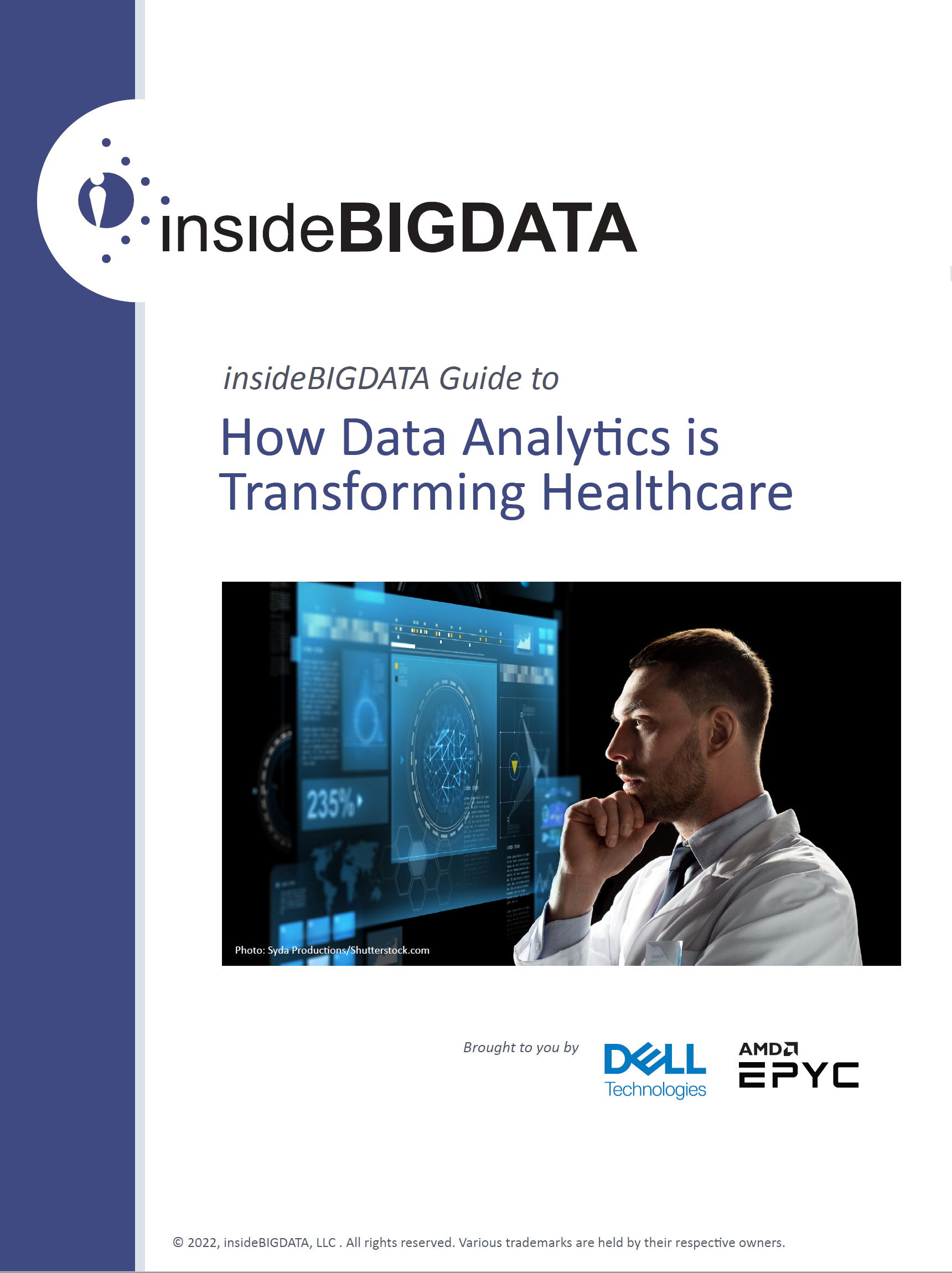Sponsored Post
Data-driven healthcare
When the average person imagines cutting-edge medical research, they picture doctors and scientists in white coats surrounded by chemicals, beakers, and specialized equipment. But the truth is that some of today’s greatest medical innovations come from a very different setting—people sitting at computers running analytics software.
This is no secret to people involved in the healthcare industry, of course. Administrators, physicians, researchers, and students are all aware that data analytics is in the process of transforming healthcare around the world. In fact, a Stanford Medicine report on “The Rise of the Data-Driven Physician” revealed that “nearly three-quarters of all medical students and nearly half of all physicians are planning to pursue additional education in data-oriented such as advanced statistics and data science.”
In addition, organizations are investing vast sums in analytics technology. Market researchers say that the global healthcare analytics market will likely be worth $39.7 billion in 2022 and is increasing at a 19% compound annual growth rate (CAGR).
Similarly, a Huron Consulting Group report titled “Embracing Healthcare’s Digital Transformation” found that nearly half of healthcare leaders surveyed (47%) are looking to data management and analytical decision making to help their organizations grow.
However, that same report added, “Digital, technology, and analytics strategies exist for nearly all organizations, yet only 30% have begun to execute on those plans.”
If your organization is one of the many that is still in the early stages of implementing its big data analytics strategy, you likely still have many unanswered questions. This technology guide, “insideBIGDATA Guide to How Data Analytics is Transforming Healthcare,” sponsored by Dell Technologies, provides an overview of some of the trends influencing big data in healthcare, the potential benefits, likely challenges, and recommended next steps.
Challenges of big data in healthcare
In order to realize all the potential benefits of big data analytics, healthcare organizations will also need to overcome some significant obstacles. Here are five of the most significant:
REGULATION
Because of the need for patient privacy, healthcare is one of the most heavily regulated industries on the planet. Any project that deals with patient or institutional data will require strict governance to make sure that it complies with all relevant regulations.
In some regions, such as the European Union, governments prevent private data from being stored or processed outside the home country. This can make it difficult or inadvisable to use public cloud computing services for data storage or analytics. Organizations may also need to anonymize and/or encrypt data in order to comply with relevant regulations. And in many cases, they will also need to have policies and procedures in place that allow patients to access and potentially delete their personal data should they choose to do so.
LACK OF STANDARDIZATION
Different organizations record and store data in different formats. That can make it extremely difficult to combine data from different sources and come up with any meaningful conclusions.
For example, a Wall Street Journal article about efforts to create a cancer database reported that the agency involved “found more than 60 different versions of how white blood cell counts—a fundamental biomarker for cancer patients—were recorded.” The amount of data cleansing required to standardize data in these situations can be daunting. However, some regulation that promotes interoperability among EHRs is helpful to improve the situation—albeit slowly.
DATA QUALITY
The conclusions you can draw from your big data analytics are only as good as the data feeding those solutions. Poor data quality and biased data are problems that plague analysts in all industries, but it can be particularly problematic in healthcare, where the stakes are so high.
Harvard’s Xiao-Li Meng, the Whipple V.N. Jones Professor of Statistics, says that doing an analysis based on biased data is worse than doing no analysis at all. “If you have the resources, invest in data quality far more than you invest in data quantity,” Meng said. “Bad-quality data is essentially wiping out the power you think you have. That’s always been a problem, but it’s magnified now because we have big data.”
DATA SILOES
Another chronic problem for healthcare organizations is the existence of data siloes. Organizations use a lot of different systems and applications that all have their own data stores. Most healthcare big data projects require significant effort in getting information from the places where it resides into a centralized system where it can be combined with other data and analyzed.
HARDWARE REQUIREMENTS
In order to process the workloads generated by big data analytics, you need the right infrastructure. That means flexible servers with fast processors and GPUs that can handle the demands of machine learning and predictive analytics. You’ll also need fast storage and hardware designed to scale out as your data volumes continue to grow.
What should you do today?
If your healthcare organization is like most, you have probably begun to dabble with big data analytics, but you have far to go before you are maximizing the potential benefits. The good news is that it is possible—and even preferable—to start small and then scale your efforts.
Experts recommend the following steps:

STEP 1 – ENGAGE YOUR STAFF
Big data analytics has the potential to benefit nearly every department in your organization. Start by discussing the possibilities with your staff members and get their ideas for how big data analytics might help your organization accomplish its goals and become more efficient. Your workers are your best source of insights into the questions you need your analytics to answer, and engaging them early can help you generate support that will be critical in later stages of your efforts.
STEP 2 – LOOK FOR “QUICK WINS”
One of the biggest mistakes that healthcare organizations make in regard to big data analytics is that they try to do too much too soon. Instead of trying to wrangle all your organization’s data into one massive data lake, begin by identifying opportunities for significant improvements that require a smaller amount of effort. These pilot projects are much more likely to generate a positive return on investment, and you can complete them much more quickly. They also help build your team’s expertise and the excitement around doing more with your data. Once you have a few successes under your belt, you can think about tackling a larger initiative.
STEP 3 – GET THE RIGHT INFRASTRUCTURE IN PLACE
To support your big data analytics initiative, you’ll need to have the right combination of hardware, software, and/or services in place. Your IT team will need to conduct a thorough review of the assets your organization already has, as well as an assessment of what will be necessary to support your efforts as they grow. Performance, flexibility, and scalability will be key. You’ll also need to keep your compliance requirements in mind, which may limit your ability to use cloud services. (See sidebar.)
STEP 4 – SCALE OVER TIME
As you experience success, you’ll want to make big data analytics tools available to more teams within your organization. Use what you learned in your initial projects to optimize your later efforts. As your efforts expand, you’ll find more useful data and more ways to apply your analytics tools to answer questions that are important to your organization.
STEP 5 – CONTINUE LEARNING
A big data analytics project is never truly finished because the data volumes continue to grow and the available technology continues to improve. New advances in artificial intelligence and machine learning are making new approaches possible on an almost daily basis. By staying abreast of the latest developments, your team will be better positioned to take advantage of new opportunities as they emerge.
The Huron Consulting Group report summarized the current situation well when it said, “The acceleration of digital tools, technology, and analytics within healthcare continue to be the industry’s greatest challenge and opportunity. Looking ahead, digital tools and data analytics will underpin the transformation of all aspects of business operations and care delivery.” You can help keep your organization at the forefront of this transformation by investing in big data analytics technology and supporting your staff as they implement analytics projects.
For more information, visit delltechnologies.com/healthcare.
Over the past few weeks we’ve explored these topics:
- Data-driven healthcare; What is big data?; Trends affecting big data in healthcare
- Benefits of big data in healthcare
- Challenges of big data in healthcare; What should you do today?; Choosing the right infrastructure for big data analytics
Download the complete iinsideBIGDATA Guide to How Data Analytics is Transforming Healthcare technology guide courtesy of Dell Technologies and AMD.





Oh, wow! My colleagues just discovered another company which has similar business model as ours and I see that as a competition which we need to beat through better strategies. Hence, shout out to you for talking about how data analytics are something we could utilize to our benefit if we upgrade technical equipment within our workplace first. Time to employ a professional to help us set up the perfect system to keep us ahead.